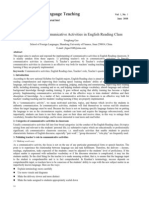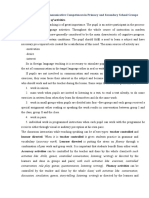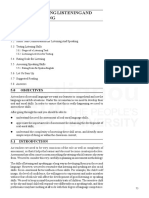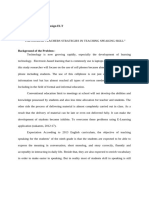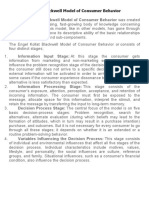OBSERVATION GRID 222
OBSERVATION GRID 222
Uploaded by
Hicham ChaibiCopyright:
Available Formats
OBSERVATION GRID 222
OBSERVATION GRID 222
Uploaded by
Hicham ChaibiCopyright
Available Formats
Share this document
Did you find this document useful?
Is this content inappropriate?
Copyright:
Available Formats
OBSERVATION GRID 222
OBSERVATION GRID 222
Uploaded by
Hicham ChaibiCopyright:
Available Formats
OBSERVATION GRID
1. THE LEARNER
1.1 Attending to the learner
Strategies deployed by the teacher: call Ss by name, nod, smile, eye contact, reprimanding
look, touch.
Reflective questions:
Were some Ss named or attended to more often than others?
Does the seating arrangement lend itself to a particular spread of teacher attention?
Do weaker or stronger Ss tend to ‘disappear’?
What general conclusions can you draw about attending behavior?
1.2 Motivating the learner
Consider the students’ response to the teacher, involvement in tasks, willingness to ask when
uncertain, tolerance of other students.
Reflective questions:
Were Ss involved in the learning process?
Did Ss exhibit willingness to ask when uncertain?
To what extent were Ss tolerant of their peers?
1.3 The learner as doer
Learning by doing embraces a large range of activities, cognitive (thinking), affective
(feeling), and physical.
Tasks may involve: thinking, feeling, acting, moving about, prioritizing, ranking, making
judgements, negotiating, interacting with others, consulting other sources of information.
Reflective questions:
What the learners do?
What does this involve?
What is the teacher’s purpose?
What is the balance of cognitive, affective, physical activities involved in the lesson?
Is the teaching methodology congruent/compatible with the learning styles of the Ss?
1.4 Learner expected level
Recognize the overt signs of learner level as well as aspects of teaching that indicate that the
teacher is accommodating the learner level.
Accommodation strategies:
re-formulates directly to learner, uses Ss as a model of lg pattern, varying speed of language,
varying complexity of language, varying length of wait time, calling in stronger Ss for
“model” answers, pairing and grouping arrangements.
Indicators of challenge
Non-comprehension in facial expression, Ss wait time before response, first respondent does
not offer the correct answer, a learner looks sideways at a neighbor before starting writing.
Indicators of ease
Ss gets started quickly, plethora of responses to teacher’s questions, expected time needed for
tasks over-calculated.
Reflective questions:
How aware are you of the levels within the class?
How keenly is this awareness reflected in your teaching?
What aspect of the lesson most reflect this awareness?
1. LANGUAGE
2.1 The teacher's use of meta-language
Here it is used to mean teacher talk which is not related to the language being presented: the
language a teacher uses to allow the various classroom processes to happen, that is, the
language of organizing the classroom. This includes the teacher’s explanations, response to
questions, instructions, giving of praise, correction, collection of homework, etc. While a
general aim of the classroom is to minimise teacher talking time (TTT) so as to encourage
student talking time (STT), meta-language itself is an important source of learning because it
is genuinely communicative. For example, when a teacher praises a student or asks
another one to be quiet, or sets up a task, the language used is genuinely contextualised,
purposeful and communicative, and therefore a potentially rich source of input.
2.2 Adequate use of the language of questions
Yes/no questions
short answer/retrieval-style questions
Open-ended questions
Display questions (requesting info already known to the questioner: what color is this pen?)
Referential questions (requesting new info: what did you study?)
Non-retrieval, imaginative questions (questions that do not require the learner to retrieve
given information but instead call on inferred information or information in which an option
or judgement is called for) ‘What do you think the writer was suggesting by making the
central character an animal?’
2.3 Helpful language of feedback to error
It has been said (Zamel 1981) that the information component of teacher feedback is crucial to
the learner’s learning process. According to Zamel, feedback is most effective when it:
— points out critical features of the language;
— gives information that allows the student ‘to discover by oneself’ rules and principles of
language;
— reduces ambiguity of choice for the learner.
On the basis of your analysis, comment now on the language of feedback in these terms:
a) Was the information supported by other messages through different media, such as gesture,
visual?
b) Was the message appropriately limited (not overloaded)? Did it reduce, rather than
increase, ambiguity?
2.4 Using language echoes
Echoes do not further an exchange; they are in fact ‘dead ends’. One common criticism of
echoing is that an echo is ‘not a-natural response’: that is, it is unlikely to occur in contexts
outside of the classroom
2.5 Using language as the negotiation of meaning
Interlanguage studies (e.g. Doughty and Pica 1986; Long and Porter 1985) have revealed that
the language used by learners in the classroom, in the actual processes of engaging with
materials and with each other, is a significant factor in their language learning.
(“Interlanguage’ refers to the language produced by non-native speaking learners who are in
the process of learning.)
Language operations through which meaning may be negotiated:
A confirmation check, a comprehension check, a clarification request, a repetition.
The term conversational modification, used by Doughty and Pica (1986), refers to the various
means by which learners negotiate the meaning of input so as to make it comprehensible and
personally meaningful.
3.LEARNING
Few would now doubt that people learn best when they are relaxed, comfortable, unstressed,
interested and involved in what is going on, and motivated to continue. Regrettably, there is
no hard-and-fast, definitive list of what makes an environment conducive to learning. We
cannot, for example, say that ‘the more a teacher smiles, the more relaxed the students are’ as
this is absurdly simplistic. Nonetheless, there may be a lot to be gained from developing an
awareness of the affective factors that influence learning.
One difficulty in this task is that the very presence of ‘an outsider’ among the learning
community will affect it in subtle, perhaps imperceptible ways. This is difficult to avoid but
might be minimised by your awareness and your maintaining a very low profile. (your
presence should be as unobtrusive as possible)
3.1 Clear learning objectives
Smart objectives, linguistic, functional, contextual aspects.
3.2 Appropriate learning environment
Physical factors (room size, ventilation…) teacher behaviour (smiles, nods, calls by name)
3.3 Preparing for learning
Warm up, pre-teaching of key vocabulary items,
3.4 Checking learning
Checking should be consistent throughout the stages of the lesson and it should propel the
lesson onwards towards its objective. forms of checking: verbal, non-verbal signals.
3.5 Learning and teaching compared
The construction of meaning is an essentially personal experience for each individual. “each
lesson is a different lesson for every learner” there is no one-to-one correspondence between
teaching aims and learning outcomes.
4.THE LESSON
4.1 Lesson planning
4.2 Openings
Linking the new lesson to the previous one, review,
Closures:
Signaling the end of a lesson with an abrupt ‘Stop! is clearly not a conducive way to wind
down a lesson! How can a teacher ease the end of an activity into the end of a lesson?
b) Is making space for questions from students a good way of closing a lesson?
c) Is it important how students feel as they leave the classroom?
d) Is it worthwhile to review the lesson’s aims and content at the end of the lesson?
4.3 Clear lesson stages and transitions
4.5 Dealing with lesson breakdowns
An interruption to a lesson, covering anything from minor hiccups to a major impasse. It is a
point in a lesson when due to a communication problem or misunderstanding, the lesson is
unable to proceed. In the language learning classroom, where the target language being
learned is also the medium of instruction, it is highly probable that breakdowns, small or
large, will occur. It is important to note that the term ‘breakdown’ is not a negatively-laden
term and does not imply hostility or failure. Furthermore, the language used to negotiate the
breakdown is itself meaningful and valuable and as such, constitutes an important source of
real input for language learners. One might call it the very heart of the communicative
classroom.
5. METHODOLOGY
5.1 The methodology of teaching is appropriate to the component taught
5.2 There are skill-getting tasks/activities
5.3 There are skill-using tasks/activities
6. TEACHING SKILLS AND STRATEGIES
6.1 Teacher presence
6.2 Teacher checks
6.3 Teacher responses to students’ responses
6.4 Giving instructions
6.5 Managing error
If teachers corrected every language error made in their class, far too much classroom time
would be given over to correction. This has negative implications in that it might reduce
learner willingness to take risks and experiment.
Teachers necessarily differentiate between errors that require immediate attention and errors
that are better ignored or treated in another way or at another time. This is one of the many
choices a teacher makes in regard to learner error.
You might also like
- Power of Full Engagement v.1 PDFDocument7 pagesPower of Full Engagement v.1 PDFjeffNo ratings yet
- Principles For Teaching Across Macro-SkillsDocument7 pagesPrinciples For Teaching Across Macro-SkillsLebiram Mabz100% (1)
- M1 S2 TEFL Didactics FadelDocument15 pagesM1 S2 TEFL Didactics FadelAJD BHHNo ratings yet
- Development of The Four Basic Linguistic Skills: Listening, Speaking, Reading and Writing. Communicative Competence in EnglishDocument10 pagesDevelopment of The Four Basic Linguistic Skills: Listening, Speaking, Reading and Writing. Communicative Competence in EnglishMvp LoloNo ratings yet
- Caruth - Violence and TimeDocument3 pagesCaruth - Violence and TimeN100% (2)
- PTEG FunctionsNotions LevelA1Document9 pagesPTEG FunctionsNotions LevelA1Brem GutierrezNo ratings yet
- Summarizing Book Chapters 13Document6 pagesSummarizing Book Chapters 13Lifyan AriefNo ratings yet
- Module 2 SpeakingDocument2 pagesModule 2 SpeakingJessel DilaoNo ratings yet
- REVISION QUESTIONS AND TASKSDocument10 pagesREVISION QUESTIONS AND TASKSLan Nhi PhanNo ratings yet
- Teaching English in The Elementary Grades - RMDBDocument20 pagesTeaching English in The Elementary Grades - RMDBLovely Joy Romano100% (1)
- Communicative CompetenceDocument18 pagesCommunicative CompetenceLara OñaralNo ratings yet
- Task_based_language_teaching_pptxDocument18 pagesTask_based_language_teaching_pptxitsmey879No ratings yet
- Chapter 1Document6 pagesChapter 1recahhaNo ratings yet
- Teaching Language Skills Final Exam: Answer Only FIVE of The Following QuestionsDocument4 pagesTeaching Language Skills Final Exam: Answer Only FIVE of The Following QuestionsMahdi MirzapourNo ratings yet
- Teaching EFL Quick GuideDocument75 pagesTeaching EFL Quick GuideJose Batista De LeónNo ratings yet
- Module 3. A Brief History of Language Teaching 2Document10 pagesModule 3. A Brief History of Language Teaching 2Memy Muresan100% (1)
- Free Tefl2Document18 pagesFree Tefl2AmerNo ratings yet
- Implementing Communicative Activities in English Reading ClassDocument5 pagesImplementing Communicative Activities in English Reading ClassDodi SweatitanNo ratings yet
- Applied LinguisticsDocument2 pagesApplied Linguisticssamirasamira123msNo ratings yet
- Leo M. Atienza-English 111 Second Language Acquisition-Task-Based Language Teaching and Reflective TeachingDocument68 pagesLeo M. Atienza-English 111 Second Language Acquisition-Task-Based Language Teaching and Reflective TeachingLeoAtienzaNo ratings yet
- The Principles of Language LearningDocument27 pagesThe Principles of Language LearningRoseiliza Delos SantosNo ratings yet
- Approaches For Language Arts Teaching: ContinuationDocument35 pagesApproaches For Language Arts Teaching: ContinuationIrish Kay RiezaNo ratings yet
- Engle ZaDocument29 pagesEngle ZadoinaNo ratings yet
- Task Based Language TeachingDocument13 pagesTask Based Language TeachingSupansa SirikulNo ratings yet
- Topic 7Document26 pagesTopic 7Paula Garcia-ochoaNo ratings yet
- Module in Approaches For Language Arts TeachingDocument6 pagesModule in Approaches For Language Arts Teachingrosevicabangay100% (1)
- M1_S2_TEFL_DidacticsTD (1)Document15 pagesM1_S2_TEFL_DidacticsTD (1)ParadiseIhopeforNo ratings yet
- Classroom InteractionDocument22 pagesClassroom InteractionSusanaNo ratings yet
- Mata Kuliah: TEFL 1 NAMA: Rusli Abednego NIM: 041674729: 1. Natural Aprroach Teaching MethodDocument7 pagesMata Kuliah: TEFL 1 NAMA: Rusli Abednego NIM: 041674729: 1. Natural Aprroach Teaching MethodRusli AbednegoNo ratings yet
- U Main Types of Strategies and ActivitiespptxDocument21 pagesU Main Types of Strategies and Activitiespptxapi-247091657No ratings yet
- Unit 5Document14 pagesUnit 5IrynaNo ratings yet
- TEFL SummaryDocument20 pagesTEFL Summaryseong sooNo ratings yet
- Content-Based, Task-Based, and Participatory Approach SLIDESDocument26 pagesContent-Based, Task-Based, and Participatory Approach SLIDESMoises Ramirez50% (2)
- Teaching Methods QuizDocument18 pagesTeaching Methods QuizAmerNo ratings yet
- Isl Week 4Document5 pagesIsl Week 4Najwa GhazaliNo ratings yet
- Task Based Learning and Competency BasedDocument17 pagesTask Based Learning and Competency Basedmeymirah100% (1)
- Classroom Interaction: Escuela Normal Superior "Moisessaenzgarza" Lengua Extranjera 4°semestre English 2Document25 pagesClassroom Interaction: Escuela Normal Superior "Moisessaenzgarza" Lengua Extranjera 4°semestre English 2Asfir MuhdinNo ratings yet
- Audio-Lingual MethodDocument2 pagesAudio-Lingual Methodapi-221700460No ratings yet
- EnglishDocument45 pagesEnglishscce.libraryNo ratings yet
- Training-Programme English LanguageDocument5 pagesTraining-Programme English LanguageAtaTahirNo ratings yet
- We Do Need MethodDocument5 pagesWe Do Need MethodVeronica VeroNo ratings yet
- Listening Strategies and Applications in EFL Classroom: II. MotivationDocument34 pagesListening Strategies and Applications in EFL Classroom: II. MotivationCesar MartinezNo ratings yet
- ETECS 2020 - Precious Pedraza CompressedDocument20 pagesETECS 2020 - Precious Pedraza CompressedLEYDA SAAVEDRA TRUJILLONo ratings yet
- fundamentos resumenDocument5 pagesfundamentos resumenbarbypuchettaNo ratings yet
- Task-Based Language TeachingDocument26 pagesTask-Based Language Teachingyohanessy134No ratings yet
- Language Learning and Teaching PrinciplesDocument25 pagesLanguage Learning and Teaching Principlessubramani muthusamyNo ratings yet
- Questions 1Document9 pagesQuestions 1iqra khanNo ratings yet
- Speaking TBL 2 IndonesianDocument17 pagesSpeaking TBL 2 IndonesianEko Wahyu ApriliantoNo ratings yet
- Final Assignment AlDocument9 pagesFinal Assignment AlHiền Anh NguyễnNo ratings yet
- Assignment Methodological Approaches: Students' NamesDocument11 pagesAssignment Methodological Approaches: Students' NamesOscar Jose UnamunoNo ratings yet
- 9 Mistakes To Avoid When TeachingDocument4 pages9 Mistakes To Avoid When TeachingSonsaku HakufuNo ratings yet
- Free Tefl26Document18 pagesFree Tefl26AmerNo ratings yet
- MID-INSTRUCTIONAL DESIGN Eko SahputraDocument8 pagesMID-INSTRUCTIONAL DESIGN Eko SahputrawantawidharmaNo ratings yet
- Uas Classroom Management: AnswerDocument5 pagesUas Classroom Management: Answerreza jazmi100% (1)
- Communicative Approach: An Introduction To The Communicative ClassroomDocument10 pagesCommunicative Approach: An Introduction To The Communicative ClassroomZeynabNo ratings yet
- Techniques and Principles in Language TeDocument45 pagesTechniques and Principles in Language TeMicaela RojasNo ratings yet
- Integrated Language Teaching (Autosaved)Document20 pagesIntegrated Language Teaching (Autosaved)Nicole AquinoNo ratings yet
- CORE READING - Teacher Talk TimeDocument5 pagesCORE READING - Teacher Talk Timeozigan16No ratings yet
- Literature Review: 2.2.1 Definition of Speaking SkillDocument9 pagesLiterature Review: 2.2.1 Definition of Speaking SkillUswatun HasanahNo ratings yet
- Teacher Induction Training: Synthesis Article: Module 4: Using Course BooksDocument10 pagesTeacher Induction Training: Synthesis Article: Module 4: Using Course BooksLílian MotaNo ratings yet
- CLT Instruction and LearningDocument7 pagesCLT Instruction and Learningvictoria puycan romeroNo ratings yet
- A Comprehensive Guide To Vetting MenDocument31 pagesA Comprehensive Guide To Vetting MenJulianny Soto100% (1)
- PreviewpdfDocument61 pagesPreviewpdfSuhendarNo ratings yet
- Reviewer 3rd Quarter Exam Practical Research 1Document6 pagesReviewer 3rd Quarter Exam Practical Research 1ninamercado173No ratings yet
- The DAPPR TestDocument1 pageThe DAPPR TestThom KilleenNo ratings yet
- Rasmussen and Practical Drift Drift Towards Danger and The Normalization of DevDocument10 pagesRasmussen and Practical Drift Drift Towards Danger and The Normalization of Dev18rosa18No ratings yet
- WEEK 5 PPT - Social PsychDocument25 pagesWEEK 5 PPT - Social PsychNetsu JenNo ratings yet
- DLP ACTIVITY FOR INSETDocument4 pagesDLP ACTIVITY FOR INSETailamarie.mandaweNo ratings yet
- Book ListDocument103 pagesBook ListScribdTranslationsNo ratings yet
- How To Be An ExistentialistDocument3 pagesHow To Be An ExistentialistDaniel ValleNo ratings yet
- SHARED Characteristics of White Supremacy Culture OriginalDocument1 pageSHARED Characteristics of White Supremacy Culture OriginalTymmony KeeganNo ratings yet
- Perguntas ICP (ENGLISH) JDJJFFDocument9 pagesPerguntas ICP (ENGLISH) JDJJFFFernanda Gomes100% (1)
- 1 Running Head: A Successful Desuggestopedia ClassroomDocument3 pages1 Running Head: A Successful Desuggestopedia ClassroomlingjingNo ratings yet
- The Social Change Model of Leadership: A Brief OverviewDocument4 pagesThe Social Change Model of Leadership: A Brief Overviewsafia100% (1)
- Literary_Terms_Crossword_answer_key (1)Document1 pageLiterary_Terms_Crossword_answer_key (1)nevaehsylvester7No ratings yet
- AWL ListDocument11 pagesAWL ListMuratcan YılmazNo ratings yet
- The Engel Kollat Blackwell Model of Consumer BehaviorDocument18 pagesThe Engel Kollat Blackwell Model of Consumer BehaviorVincy Paul FNo ratings yet
- Thi Anh 11 1Document7 pagesThi Anh 11 1nguyenhuongmo.qb2No ratings yet
- Rewrite Using IdiomsDocument5 pagesRewrite Using Idiomsrabbi175No ratings yet
- Compo 4 - HKDSE English School Fair WritingDocument3 pagesCompo 4 - HKDSE English School Fair WritingEdisonNo ratings yet
- Innovative Teaching Syllabus 3Document2 pagesInnovative Teaching Syllabus 3Frey Jenny GragasinNo ratings yet
- Suggested Lesson Plan For I-Learn Smart StartDocument1 pageSuggested Lesson Plan For I-Learn Smart StartThúy ThanhNo ratings yet
- Order 233666728 - PsychologyDocument10 pagesOrder 233666728 - PsychologyLindaNo ratings yet
- AQABusiness 10.2Document22 pagesAQABusiness 10.2kubapaul10No ratings yet
- Lesson Plan 03 Desriptive EssayDocument8 pagesLesson Plan 03 Desriptive EssayNaureen MumtazNo ratings yet
- JBS 2020Document17 pagesJBS 2020Adnan AdilNo ratings yet
- Masters Thesis Proposal SampleDocument4 pagesMasters Thesis Proposal Samplebsam2hwd100% (1)
- Differentiate Terminology From Repeating Non Terminating Decimal Quotients Grade 6Document18 pagesDifferentiate Terminology From Repeating Non Terminating Decimal Quotients Grade 6Grace MascarinaNo ratings yet
- Entrep 2Document3 pagesEntrep 2tayrown88No ratings yet

















